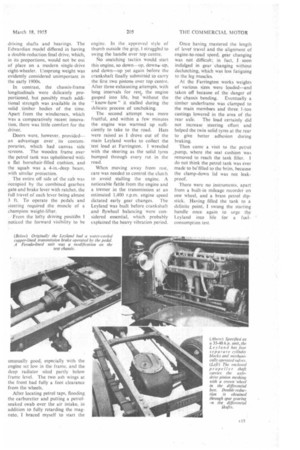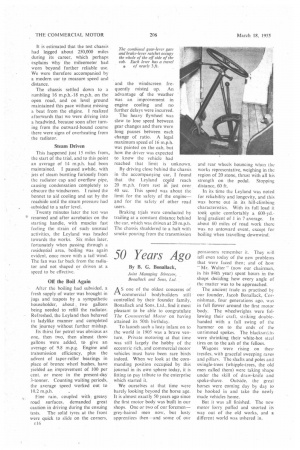riek Dra p EDESTR1ANS stopped and stared, and drivers sounded their
Page 114

Page 115

Page 116

If you've noticed an error in this article please click here to report it so we can fix it.
horns in acknowledgment as Grandma, an Edwardian Leyland chassis and predecessor of the modern Comet, showed her paces in her native surroundings. At the time when this chassis was built, the Leyland Ladies were rather more buxom; my particular fancy weighed over 44 tons, with a platform body, and carried a 3-ton payload.
Members of the wily sex are sometimes reluctant to declare their ages, and this applies to the Leyland, which may have been built at any time between 1906 to 1908, or before makers and operators attached much importance to posterity.
It is known that the vehicle was purchased by Carter Paterson and Co., and modernized to the extent of having a windscreen fitted in the mid-I920s. A few years ago it was retired from everyday -service, and now resides in Leyland, to make an occasional appearance at local functions, such as any grand old lady might be expected to do.
I collected the chassis from the museum, where it stood sans body but with its varnished cab and bonnet gleaming, as ever, and brass head lamps all ready to be lit by the touch of a match, provided there was not a stiff breeze at the time. With no birth certificate, and few details known of the specification, I could r14
only surmise its wo.rkings from a visual examination.
Having attempted to raise the bonnet and swing the starting handle, I decided that the older generation must have been tougher than I am. Each side of the bonnet was a sturdy piece of iron of 14 s.w.g. or 16 s.w.g., which would have remained closed without the need for the two hefty spring-loaded clamps which held it.
The engine was accessible in every
detail. Four large cylinder blocks were bolted to a massive cast-iron case, and open tappet blocks were evidence of accessibility. Large inspection plates on the side of the crankcase provided rah ns for adjusting the troughs in which the connecting-rod dippers scooped oil for big-end lubrication. • The absence of dynamo, battery and starter simplified the knowledge required by the driver and main
tenance staff, and left more space below the bonnet.
A mechanical linkage to the carburetter butterfly for slow-running control was coupled to a lever below the steering wheel, but the means for retarding or advancing the magneto from the cab was defunct. The large gearbox was a separate unit from the engine, to facilitate inspection and maintenance of the clutch. From the appearance of the gearbox I assumed that it had a chain drive, with dog engagement for each ratio.
Behind the gearbox there reposed a contracting-band foot brake, which effectively locked the wheels and emitted a heavy smoke cloud during every brake test. The hand brake was also linked to the rear wheels, and for both braking systems there were large turnbuckle adjusters threaded on the f-in.-diameter rods. From the gearbox, the transmission was enclosed in a torque tube, doubtlessly to avoid imposing twist on the rear springs.
In assembly the rear axle of the old Leyland was similar to that of the present Comet, having a separate centre section with bolt-on trumpetshaped extensions to house the driving shafts and bearings. The Edwardian model differed in having a double-reduction final drive, which, in its proportions, would not be out of place on a modern single-drive eight-wheeler. Unsprung weight was evidently considered unimportant in the early 1900s.
In contrast, the chassis-frame longitudinals were delicately proportioned, but possibly much additional strength was available in the solid :timber bodies of the time. Apart from the windscreen, which was a comparatively recent innovadon, there was little comfort for the driver.
Doors were, however, provided— an advantage over its contemporaries, which had canvas side screens. The wooden frame over the petrol tank was upholstered with a flat horsehair-filled cushion, and the squab was a 4-in.-deep beam, with similar protection.
The entire off side of the cab was occupied by the combined gearbox gate and brake lever with ratchet, the full travel of each lever being almost 3 ft. To operate the pedals and steering required the muscle of a champion weight-lifter.
. From the lofty driving positiOn I noticed the forward visibility to be engine. In the approved style of thumb outside the grip, I struggled to swing the handle over top centre.
No snatching tactics would start this engine, so down—up, down.-up, and down—up yet again before the crankshaft finally submitted to carry the first two pistons over top centre. After three exhausting attempts, with long intervals for resct, the engine gasped into life, but without the " know-how " it stalled during the delicate process of unchoking.
The second attempt was more fruitful, and within a few minutes the engine was warmed up suffi
ciently to take to the road. Hats were raised as I drove out of the main Leyland works to collect the 'test load at Farrington. I wrestled with the steering as the solid tyres bumped through every rut in the .road.
When moving away from rest, care was needed to control the clutch to avoid stalling the engine. A noticeable Pattie from the engine and a tremor in the transmission at an estimated 1,400 r.p.m. engine speed dictated early gear changes. The Leyland was built before, crankshaft andflywheel balancing were considered essential, which probably explained the heavy vibration period. Once having mastered the length of levee travel and the alignment of engine-to-road speed, gear changing was not difficult; in fact, I soon indulged in gear 'changing without declutching, which was less fatiguing to the leg muscles.
At the Farrington works weights of various sizes were loaded—and taken off because of the danger of the chassis bending. Eventually a timber underframe was clamped to the main members and three 1-ton castings lowered in the area of the rear axle. The load certainly did not increase steering effort and helped the twin solid tyres at the rear to give better adhesion during braking.
Then came a visit to the petrol ,pump, where the seat cushion was removed to reach the tank filler. I do not think the petrol tank was ever made to be' filled to the brim, because the clamp-down lid was not leakproof.
There were no instruments, apart from a built-in mileage recorder on one wheel, and a brass petrol dipstick, Having filled the tank to a definite point, I swung the starting handle once again to urge the Leyland into life for a fuelconsumption test. It is estimated that the test chassis had logged about 250,000 miles during its career, which perhaps explains why the mileometer had worn beyond further reliable use. We were therefore accompanied by a modern car to measure speed and distance.
The chassis settled down to a rumbling 16 m.p.h.-18 m.p.h. on the open road, and on level ground maintained this pace without missing a beat from the efigine. I realized afterwards that we were driving into a headwind, because soon after turning from the outward-bound course there were signs of overheating from the radiator.
Steam Driven
This happened just 15 miles from. the start of the trial, and to this point an average of 14 m.p.h. had been maintained. I paused awhile, with jets of steam bursting furiously from the radiator cap and overflow pipe, causing condensation completely to obscure the windscreen. I raised the bonnet to aid cooling and sat by the roadside until the steam pressure had subsided to a safer level.
Twenty minutes later the test was
as resumed and after acrobatics on the starting handle, with muscles fast feeling the strain of such unusual activities, the Leyland was headed towards the works. Six miles later, fortunately when passing through a residential area, boiling was again evident, once more with a tail wind. The fan was far back from the radiator and not shaped or driven at a speed to be effective.
Off the Boil Again
After the boiling had subsided, a fresh supply of water was brought in jugs and teapots by a sympathetic householder, about two gallons being needed to refill the radiator. Refreshed, the Leyland then behaved ia ladylike manner and completed the journey without further mishap.
Its thirst for petrol was obvious as one, then two, then almost three gallons were added, to give an average of 9.8 m.p.g. Engine and transmission efficiency, plus the advent of taper-roller bearings in place of bronze wheel bushes, have yielded an improvement of 100 per cent. or more in the present-day 3-tonner. Counting waiting periods, the average speed worked out to 10.2 m.p.h.
Fine rain, coupled with greasy road surfaces, demanded great caution in driving during the ensuing tests. The solid tyres at the front were quick to slide on the corners,
and the windscreen frequently misted up. An advantage a the weather was an improvement in
engine cooling and no further delays were incurred.
The heavy flywheel was slow to lose speed between gear changes and there were long pauses between each change of ratio. A legal maximum speed of 16 m.p.h. was painted on the cab, but
how the driver was expected to know the vehicle had reached that limit is unknown.
By driving close behind the chassis in the accompanying car, I found that the Leyland could reach 20 m.p.h. from rest in just over 40 sec. This speed was about the limit for the safety of the engine—
and for the safety of other road users.
Braking tr,ials were conducted by trailing at a constant distance behind the car, which was driven at 20 m.p.h. The chassis shuddered to a halt with smoke pouring from the transmission and rear wheels bouncing when the works representative, weighing in the region of 20 stone, thrust with all his strength on the pedal. Stopping distance, 60 ft.
In its time the Leyland was noted for reliability and longevity, and this was borne out in its hill-climbing characteristics. With its full load it took quite comfortably a 600-yd.long gradient of 1 in 7 average. In about 60 miles of road work there was no untoward event, except for boiling when travelling downwind.








































































































































































































































































